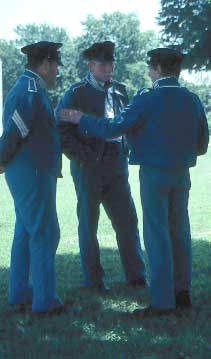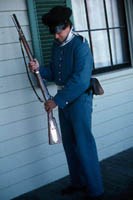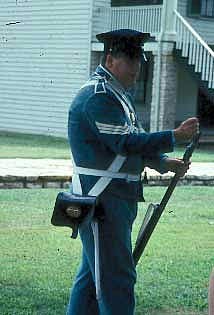
Building Blocks of the ArmyInfantry composed the bulk of all nineteenth century armies. Troops of this class sometimes bore the designation "foot." Armed predominantly with flintlock muskets, infantry consisted of two categories. Heavy infantry, also called infantry-of-the-line, were trained to fight shoulder to shoulder in rigid lines of battle. Light infantry, the second class of infantry, operated as skirmishers and fought in open order. Companies and RegimentsThe basic unit in the army was the company. A company was commanded by a captain, who was assisted by a first and second lieutenant, and an orderly sergeant. For practical purposes, the company was further divided into four squads, each commanded by a sergeant and a corporal. Each infantry company consisted of 42 privates, whereas each dragoon company could have up to fifty privates, although sickness, desertion, and detached duties often caused the numbers to fall below this level. The company tended to become the basic tactical unit and the unit on which individual pride and loyalty focused. Soldiers considered their company "home" because they worked, played, ate, slept, and sometimes died within its familiar environment. Each member of a company wore a letter denoting his company's designation: A, B, C, D, E, F, G, H, I, and K. The letter J was omitted, as it was too easily confused with the letter I. Ten companies made up a regiment, but the companies of each regiment were rarely stationed at the same post. The only time that the entire regiment got together was during wartime and for other military campaigns. Regimental field and staff consisted of a colonel, a lieutenant colonel, two majors, and an adjutant and quartermaster detailed from the line subalterns or junior officers. A sergeant major, quartermaster sergeant, and musicians composed the noncommissioned staff. Brigades, Divisions, and BattalionsDuring wartime, companies, battalions, regiments, brigades and divisions provided the army with a simple framework for both logistical and combat organization. The army's building blocks - regiments and companies - could be arranged in various combinations. A military unit of more than one but less than ten companies was designated as a battalion and usually was commanded by a lieutenant colonel or a major, depending upon the unit's size. A battalion usually consisted of companies from the same regiment, but under special circumstances, this custom was ignored. A unit larger than a regiment, called a brigade, could be produced by placing two or three regiments together under the command of a brigadier general. Two or more brigades could be placed together under the command of a major general and organized into a unit called a division. Both brigadier and major generals were aided by officers who performed the various duties of the army's staff departments. Several divisions operating in one theater, commanded by the most senior officer present, comprised an army. The US Army, however, did not retain organized brigades and divisions in peacetime and employed them only in time of war. 
U.S. Army RanksPrivatesThe private is a soldier who has no military rank. He signed up for a five-year hitch and received $7.00 a month in salary (dragoon privates received $8.00). A private could rise in ranks to that of a sergeant but that is about as high as he could go as an enlisted man. If he ever made sergeant, he could hope to earn $13.00 per month. 
Non-commisioned OfficersScott's Infantry Drill Regulations placed the ultimate responsibility for the training, well-being, and readiness of a company's enlisted men in the hands of the noncommissioned officers. The appearance and condition of the barracks and the neat and soldierly look of the men who lived in them also became the sergeant's business. NCOs had to make sure that mens' hands and faces were washed daily and that they brushed and combed their hair and changed their underwear regularly. CorporalThe rank of corporal has always been placed at the base of the non-commissinoed officer ranks. For the most part, corporals have served as the smallest unit leaders in the Army – principally as leaders of teams. Like sergeants, corporals are responsible for the individual training, personal appearance and cleanliness of their soldiers. Infantry corporals received $9.00 per month, where as dragoon corporals received $10.00. SergeantThe sergeant operates in an environment where sparks fly. Privates generally have sergeants as their first NCO leader and it is the sergeant that privates look to for example. The sergeant is responsible for the individual training, personal appearance and the cleanliness of their soldiers. They are also responsible for insuring that each member of their unit is trained to competency, that all government property issued to members of their unit is properly maintained and accounted for at all times and discrepancies are promptly reported. 1st SergeantStanding at the top of the noncommissioned hierarchy of rank, they were the "overseers" of the company's enlisted personnel. To this end, they kept the Hauptman, or Company Commander, informed of everything that went on in the company; whether NCOs were performing their duties in a satisfactory manner, that training was properly accomplished, and finally, that at the end of a busy day, that all soldiers were accounted for in their quarters. This non-commissioned officer, chosen by officers of the company, was the linchpin of the company and the discipline of the unit. The conduct of the troops, their exactness in obeying orders and the regularity of their manners, would, "in a large measure, depend upon the first sergeant's vigilance." The first sergeant therefore must be "intimately acquainted with the character of every soldier in the company and should take great pains to impress upon their minds the indispensable necessity of the strictest obedience as the foundation of order and regularity." Their tasks included maintaining the duty roster in an equitable manner, taking the daily orders in a book and showing them to their officers, making the morning report to the captain of the state of the company in the form prescribed, and at the same time, acquainting them with anything material that may have happened in the company since the preceding report. The First Sergeant also kept a company descriptive book under the captain's supervision. These descriptive books listed the names, ages, heights, places of birth, and prior occupations of all enlisted in the company. At Fort Scott, there was a First Sergeant for each company. A First Sergeant of Infantry made $16.00 in the 1840s. The information for this section came from several sources:
Experience more Life on the FrontierBack to Virtual Resource Center Home |
Last updated: May 31, 2022
